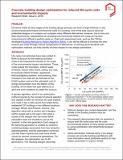| dc.contributor.author | Hester, Josh | |
| dc.contributor.author | Gregory, Jeremy | |
| dc.contributor.author | Kirchain, Randolph | |
| dc.date.accessioned | 2021-03-02T15:05:23Z | |
| dc.date.available | 2021-03-02T15:05:23Z | |
| dc.date.issued | 2018-04 | |
| dc.identifier.uri | https://hdl.handle.net/1721.1/130034 | |
| dc.description.abstract | Decisions made at early stages of the building design process can have a large influence on the environmental performance and financial costs of a building. One of the best ways to discover preferable designs is to analyze and compare many different alternatives. However, due to time and data requirements, assessments of a building’s environmental impacts and costs can be time-consuming and difficult to perform early on. Even with streamlined tools, such as the CSHub-developed Building Attribute to Impact Algorithm (BAIA), it can still be difficult to minimize lifetime impacts and costs through manual comparisons of alternatives. Combining tools like BAIA with optimization methods can help identify the best ranges for key design parameters. | en_US |
| dc.relation.ispartofseries | MIT CSHub Research Brief; Volume 2018, Issue 4 | en_US |
| dc.subject | Life Cycle Analysis | en_US |
| dc.subject | Energy Consumption | en_US |
| dc.subject | Buildings | en_US |
| dc.title | Research Brief: Concrete building design optimization for reduced life cycle costs and environmental impacts | en_US |
